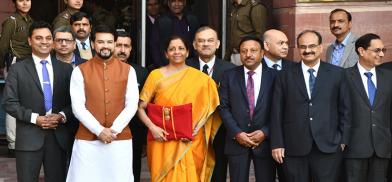For India's growth to revive, needed deep-going structural reforms
India Inc’s confidence will certainly be boosted with a more transparent and non-adversarial tax regime and a business-friendly policy framework that improves the conditions for doing business on the ground, especially in the various states, writes N Chandra Mohan for South Asia Monitor

These are challenging times for the Indian economy which has experienced six quarters of falling GDP growth, rising unemployment and dampened animal spirits of businessmen. The IMF has sharply downgraded the country’s growth prospects for 2019-20 to 4.8%, dragging down global growth as well.
As if all of this weren’t bad enough, the international business press has been critical of the Narendra Modi-led government’s policy stance, including the lacklustre union budget for 2020-21 that did nothing to fiscally stimulate a free-falling economy. “For India to grow, Mr Modi should commit to real changes” argued an editorial in the Financial Times.
This bleak assessment is not shared by the ruling NDA regime. The slowdown of the economy hardly figured even once in the finance minister’s marathon budget speech on February 1:
The fundamentals of the economy are strong and that has ensured macroeconomic stability was all that was emphasized. The Economic Survey for 2019-20 considers the moderation in India’s GDP growth to be synchronous with a global slowdown and sees an uptick in prospects in the second half of 2019-20 and 2020-21. Prime Minister Modi, too, reassured Parliament that the economy is strong; that the dream of a USD 5 trillion economy is being pursued with full speed.
What indeed is India’s economic outlook? A major problem in assessing this relates to frequent changes in data and credibility of the growth numbers. The CSO put out its first advance estimate for India’s growth at 5% for 2019-20 as compared to 6.8% in 2018-19 and 7.2% in 2017-18. But a day before budget 2020, the CSO revised downwards the numbers for 2018-19 and 2017-18 to 6.1% and 7% respectively. The likely growth during 2019-20 thus appears much better now at 5.7% because of a lower denominator! As quarterly growth during the first half of 2019-20 averaged 4.8%, the second half will have to register 6.6% to hit 5.7% for the year.
Arithmetic, however, is no substitute for reality. According to the Economic Survey, a pick-up in GDP growth from the second half of 2019-20 indeed appears probable with the NIFTY Consumption Index looking up for the first time this year, bullish stock markets, foreign investors showing confidence in the economy lagged effect of earlier interest rate cuts, better prices for farmers, rebound in industrial activity, improving growth in exports, higher foreign exchange reserves and higher Goods and Services Tax collections. GDP growth thus is projected to strongly rebound in 2020-21 by 6-6.5%, more so on a low statistical base of 5.7% in 2019-20.
Stock markets continue to rise after budget 2020 with its market-friendly measures to lower rates of personal income taxation, removal of dividend distribution tax and a wide range of measures to encourage foreign portfolio investors to invest in rupee-denominated government securities and corporate bonds, tax concessions to sovereign wealth funds to invest in long-term infrastructure, among others. To push consumption demand, the Reserve Bank of India, the country’s central bank, in its latest bi-monthly monetary policy held interest rates steady but incentivized cheaper retail lending for automobiles, residential housing and micro, small and medium enterprises.
While these measures may not immediately impact GDP growth, certain high-frequency indicators like the Purchasing Managers Index for services and manufacturing improved in January indicating that business sentiment is reviving. Industrial activity was up in November 2019. The output of core industries was positive in December 2019 after four months of contraction. Weighing down growth, however, is the fact that investments are sluggish as production and import of capital goods contracted in November and December.
Manufacturing capacity utilisation rates also fell in the second half of 2019-20 according to the central bank.
The good news for rural demand is that farmer incomes are up with higher prices for onions, potatoes, maize, cotton and pulses. Thanks to heavy and unseasonal rains during the southwest monsoon of 2019, sowings of crops during the winter/spring season are up by 9.5% up to January 31, 2020 over a year earlier. Reservoirs in the countryside are also filled to near capacity. With better soil and sub-soil moisture conditions, this augurs well for a bountiful harvest and better price realisation by farmers after March 2020. Improved terms of trade in favour of farmers is definitely a recipe for reviving demand from the current depressed levels.
Expectations of a rebound in the second half of 2019-20 and 2020-21 may have stood a better chance with stimulus measures in budget 2020. A counter-cyclical fiscal policy could have pushed the India growth story. Unfortunately, this was a missed opportunity as budgetary resources were constrained by a sharply slowing economy. As tax revenues and receipts from partial sales of equity in state-owned enterprises were substantially lower in 2019-20, total expenditures contracted as a share of GDP in 2019-20! “Perhaps, for this reason, the finance minister was silent in her lengthy speech about the growth slowdown”, argued Rathin Roy, director of the National Institute of Public Finance and Policy, in the Business Standard.
With no fiscal stimulus in Budget 2020, the finance minister appealed to India Inc to be the engine for the growth story. She urged industrialists to overcome their self-doubt and hesitation mode at a post-budget interaction organised by the Confederation of India Industry. Reviving the dampened spirits of businessmen, including foreign investors, ought to be the priority of the Modi-led government in the months ahead as sluggish investments, both foreign and domestic, are responsible for the downward spiral of growth. Inadequate employment is naturally the result. Low investment underlies the highest rate of unemployment at 6.1% in 2017-18.
The government, for its part, believes that rapid improvement in the country’s rankings on the ease of Doing Business makes it easier to trigger investment-led growth. It hopes to soon break into the ranks of the top 50 countries. Investment–led growth also depends on a more stable policy and regulatory framework than the streamlining of procedures and digitization of paperwork that has improved India’s rankings in these indicators. The biggest constraint for doing business is poor contract enforcement, lengthy arbitration and dispute settlement. The government bears a huge responsibility for that.
For India to grow, the real changes needed are deep-going structural reforms to free up the land and labour markets. The banks and non-bank finance companies must repair their balance sheets and start lending again. State-owned banks cannot become healthy without governance reforms. The initiation of such policy shifts have a bearing on the government’s intent to attract foreign investments that are shifting out of China, to spend as much as USD 1.4 trillion on infrastructure through public-private partnerships in the next five years to become a USD 5 trillion economy. The Economic Survey optimistically reckons that with India’s record of growth with macroeconomic stability, the economy is poised for a rebound towards the USD 5 trillion goal. None of this is inevitable. It is only when foreign and domestic investments materialize through an enabling business environment that the India growth story can regain its earlier robust trajectory of 7.5% beyond 2020-21.
(The writer is an economics and business commentator based in New Delhi)














Post a Comment